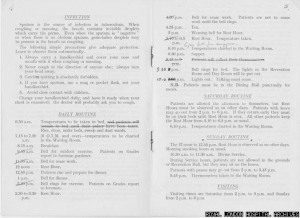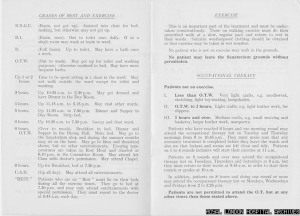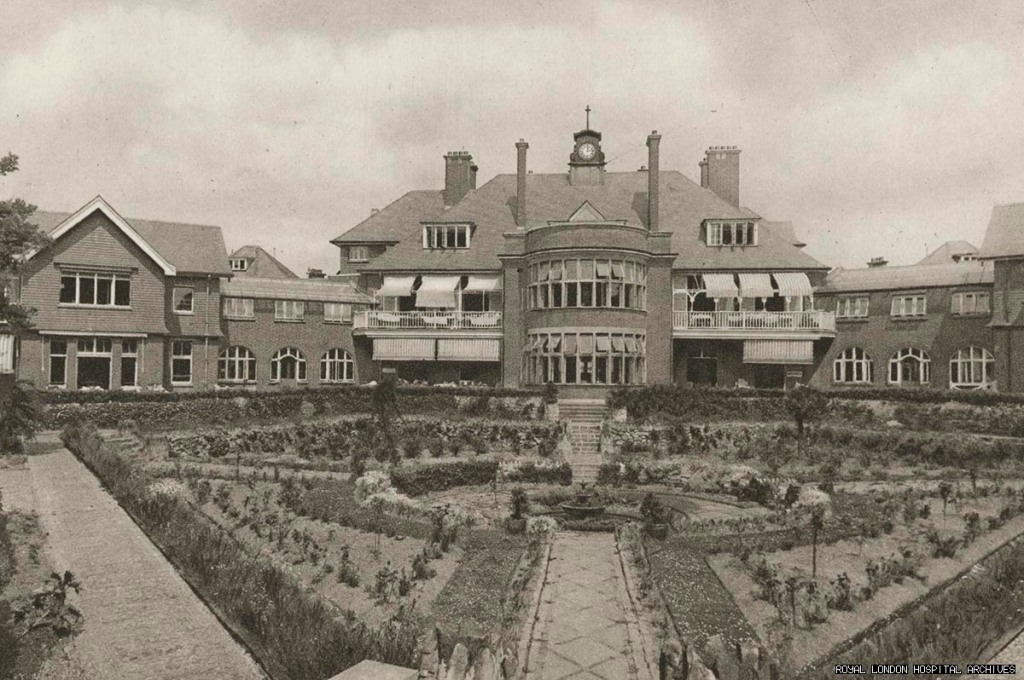“…idleness, the ennui, and the economic waste which are too often the reproach of Sanatorium treatment have no place at Frimley.” (RLHBH/A/20/5)

An aerial view of Frimley Sanatorium. Note the ‘X’ shape of the hospital, and the surrounding fields which were cultivated by patients. (Photographer unknown). RLHBH/P/2/7/2
Frimley Sanatorium was part of what was then called the Hospital for Consumption and Diseases of the Chest, Brompton, and opened in 1905 to provide a rest cure and treatment to tuberculosis sufferers in a rural setting. The objectives of the sanatorium were threefold; to submit early cases to treatment in “a dry and balancing climate for several months, with a view to arresting the disease”; to educate patients in hygienic principles; and to provide a convalescent home for other patients treated at Brompton Hospital (RLHBH/X/11). The sanatorium itself was built according to the best principles of the day, with four wings in an X shape so that all wards were south-facing, with plenty of large windows and balconies in order to support open air treatment, and open grounds which could be worked on by patients as part of their treatment.

Patients working on the construction of a reservoir at Frimley Sanatorium. RLHBH/P/2/9/6. Click to see the completed work (RLHBH/P/1/2/10).
Frimley took the most promising cases from Brompton, although it soon allowed some direct admissions from paying patients. Patients came from all walks of life, and included policemen, military men, teachers, labourers, nurses and physicians, singers, and even a dancer at the Moulin Rouge! The sanatorium was open to male and female patients, although the preference was for male patients. Treatment took several months to complete, and it was felt that women were more likely to leave early to attend to their families. Male patients were also preferred as they would be the main breadwinner in their family; poverty was a major cause of disease due to poor food and living conditions, so a healthy man to lead the household was seen as a good way to ensure that the whole family did not succumb to illness.

Rulebook for patients at Frimley Sanatorium, showing the strict daily routine (1920/30s). Click to enlarge. (RLHBH/A/1/17/2)
Rules were strict; a letter welcoming new patients (RLHBH/AL/4/3/1) acknowledged that they “may seem tiresome at first”, but stated that these were the rules which were to be the basis of the patient’s future life and health. Male and female patients were segregated unless at rare ‘mixing’ events, outside visits were strictly regulated, and the provided timetables were to be strictly adhered to. These rules were firmly enforced, and patients were discharged from treatment for disobedience. However, patients found ways around this discipline, as the following extract from a patient magazine suggests:
A Two Minute Puzzle
You’re on Grade Four. After a terrific mental struggle you make all arrangements to say good-bye to your ‘mixer’ one evening at 9.30 on Chobham Ridges. The glad moment arrives. You clasp the dear, unreluctant, tenebrous, magic form in your arms. You say, “Darling! At last we are together.” And then you discover it is Sister —.
What would you do?
What would she do?
(RLHBH/X/14)

Rulebook for patients at Frimley Sanatorium, showing the graded exercise regime. Click to enlarge.
RLHBH/A/1/17/3
Treatment at Frimley Sanatorium was based on a principle developed by its first Medical Superintendent, Dr Marcus Patterson, based on ‘auto-inoculation’, the inaccurate theory that through regulated exercise, a patient could develop a resistance to the bacterial products which tuberculosis released into their bloodstream. This belief, coupled with fears that too much bed rest might lead to idleness in the working class patients for whom Frimley cared, lead to the creation of a system of ‘graded exercise’ practised at Frimley Sanatorium.

Male patients planting pillars as part of their exercises; a key part of the treatment at Frimley Sanatorium.
RLHBH/P/2/9/3
Patients would remain on absolute bed rest until they showed suitable improvement; they would then begin to walk in the grounds, building up their miles until they were sufficiently fit to work. At this point, they would begin to perform manual tasks which supported the upkeep of the sanatorium, building up in intensity until they were at the top grade, and ready to leave. Male and female patients would work on outdoor maintenance tasks, carrying buckets of soil, wheeling barrows, mowing lawns, caring for the garden, and maintaining a kitchen garden which was to provide the sanatorium with a supply of fresh vegetables. There was even a pig farm, and serious consideration of taking on chickens during World War II. One of the earliest tasks completed by the patients of the hospital was the construction of a reservoir; a remarkable task which featured in a series of postcards, expressing delight at the surprising work done by the consumptives.
Fresh air was another component of treatment provided at Frimley, with patients advised that “You will never beat T.B. if you can’t stand a draught.” (RLHBH/AL/4/3/1). Large windows and balconies meant that patients were constantly subjected to the open air, in common with the belief derived from the Swiss sanatoria that cool fresh air was the cure for tuberculosis. This was probably more helpful than the earlier belief that patients should be kept in stuffy, closed rooms, which meant that the bacteria could thrive. Letters written to the Almoner of the hospital by patients reported that some never slept with a closed window, even decades after they received treatment, which shows how well this advice was drilled into them!
From the 1920s, in line with advances in tuberculosis treatment, the new Medical Superintendent Dr Wingfield encouraged the use of surgical treatments such as artificial pneumothorax in certain cases; the patient magazine referred to earlier frequently mentions the refills that patients would have required to keep the cavity full of gas.
The sanatorium regime didn’t stop once a patient had left Frimley; an advice booklet was given to leaving patients, advising on the best kinds of employment (outdoors), housing (an uncrowded area with a southerly aspect was to be preferred), and home décor (no heavy curtains or ornaments). Smoking was permitted only after meals, so as not to disrupt appetite. (RLHBH/A/14/74).
When the sanatorium opened, it was confidently declared that “this and similar Institutions will still fulfil an essential purpose even should the advance of medical science lead to the discovery of some agent more directly affecting the activity of the organism of the disease”. (RLHBH/A/14/69) This was not to be, and due to effective antibiotics, the need for a sanatorium had diminished by the 1960s; under the leadership of Dr Aylmer Foster-Carter, Frimley transitioned into a convalescent hospital, looking after post-operative cardiac and respiratory patients from Brompton Hospital, London Chest, and National Heart Hospital, and other London Teaching hospitals, until its eventual closure in the 1980s.


London Metropolitan Archives has the archive of Pinewood Sanatorium – opened in 1901 by the National Association for the Prevention of Tuberculosis as The London Open Air Sanatorium (ref. H69) http://www.cityoflondon.gov.uk/things-to-do/visiting-the-city/archives-and-city-history/london-metropolitan-archives/news-and-events/Pages/Pinewood-Sanatorium.aspx
LikeLike
Hi Philippa,
Thanks for your comment! It’s interesting to see what records there are of other sanatoriums, thank you very much for the link!
Rebecca
LikeLike
Very interesting to read your blog. I notice there have been no further entries since April. Does this mean you have finished your project?
LikeLike
Hi Susan,
The project isn’t over yet, but it did get a bit busy for a while! I’ll be posting some more entries over the following weeks looking at the remaining tuberculosis hospitals in our collections. Thank you for your interest in our project!
Rebecca
LikeLike
Pingback: Harefield Hospital | The Fight Against Tuberculosis
Pingback: London Chest Hospital, Victoria Park | The Fight Against Tuberculosis